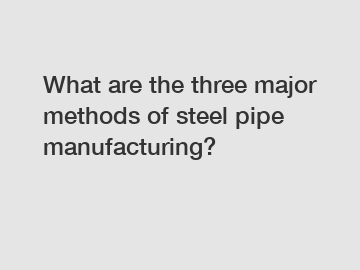Jan. 10, 2024
Minerals & Metallurgy
You will get efficient and thoughtful service from BEST STEEL.
Steel pipes are a crucial component in various industries, including construction, oil and gas, and infrastructure development. As customers, it is essential to understand the techniques used in manufacturing these pipes. In this blog, we will delve into the three major methods of steel pipe manufacturing, shedding light on their significance, process, and applications. Join us on this insightful journey of unlocking the secrets behind this versatile and indomitable material.
1. Seamless Pipe Manufacturing:

The first method we explore is seamless pipe manufacturing, which involves creating pipes without any welding joints. Seamless pipes are renowned for their strength, uniformity, and impeccable finish. This method begins with a solid cylindrical billet of steel, heated to an optimum temperature. The heated billet is then pierced to create a hollow shell, which undergoes further elongation through a process called mandrel mill rolling.
By utilizing this technique, manufacturers can produce pipes with consistent outer diameters and a range of thicknesses. This flexibility allows seamless pipes to cater to a vast array of applications, including high-pressure environments such as oil and gas pipelines, automotive frames, and structural components.
2. Electric Resistance Welded (ERW) Pipe Manufacturing:
The second method we explore is the Electric Resistance Welded (ERW) pipe manufacturing process. This technique involves welding the edges of the steel plate or strip, forming a continuous seam along its length. ERW pipes are highly preferred for their cost-effectiveness, robustness, and versatility.
So how does this process work? Initially, the flat steel plate or strip is uncoiled and trimmed to the desired width. It is then formed into a cylindrical shape and continuously fed into a series of rollers. These rollers apply the necessary pressure, forging the edges together, and creating a weld seam. Finally, the pipe undergoes a series of quality tests to ensure it meets the required industry standards.
ERW pipes find their applications in various sectors such as agriculture, construction, and plumbing due to their exceptional strength, dimensional accuracy, and ease of installation. They are commonly employed in water supply systems, scaffolding, and fencing, among other sectors.
3. Submerged Arc Welded (SAW) Pipe Manufacturing:
The third method we explore is the Submerged Arc Welded (SAW) pipe manufacturing process. This technique involves fusing the edges of steel plates through an electric arc while submerged in granulated flux. SAW pipes are renowned for their suitability in large-scale projects, including the transportation of heavy fluids and gases, as well as structural applications.
During the SAW pipe manufacturing process, the steel plates are positioned in a horizontal, rotating position. The welding head moves longitudinally, melting the edges and simultaneously depositing the granulated flux. The process continues as the welding head progresses, creating a continuous weld seam. Once completed, the pipes are subjected to rigorous quality checks before leaving the manufacturing facility.
SAW pipes find extensive utilization in oil and gas transportation, piling, and structural applications. Their ability to withstand high loads, corrosion, and extreme temperatures makes them indispensable for critical infrastructure projects.
Conclusion:
Steel pipe manufacturing is a fascinating process that has revolutionized various industries with its strength, versatility, and durability. Understanding the three major methods, namely seamless pipe manufacturing, Electric Resistance Welded (ERW) pipe manufacturing, and Submerged Arc Welded (SAW) pipe manufacturing, allows us to appreciate the intricate craftsmanship and technical prowess behind this fundamental material.
Whether it's seamless pipes with their seamless appearance and exceptional strength, ERW pipes providing economical solutions across different sectors, or SAW pipes catering to large-scale projects, each technique offers distinct advantages tailored to specific needs. The next time you come across a steel pipe, you'll have a deeper appreciation for the manufacturing process that made it possible.
So, let us celebrate the wonders of steel pipe manufacturing, and take a moment to admire the precision, expertise, and creativity that collectively contribute to the creation of these unyielding and versatile conduits.
If you are looking for more details, kindly visit our website.
For more welded pipe manufacturing processinformation, please contact us. We will provide professional answers.
If you are interested in sending in a Guest Blogger Submission,welcome to write for us!
All Comments ( 0 )